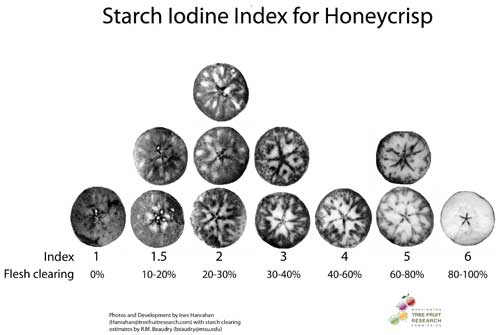Aug 30, 2012Starch chart for Honeycrisp apple fruit
Ines Hanrahan of the Washington State Tree Fruit Research Commission has recently developed a starch chart for Honeycrisp apples (see figure). The starch index ranges from 1 to 6 on this chart, which differs from that of the more commonly used chart from Cornell, which ranges from 1 to 8. In both charts, the higher the index, the less dark staining of starch by iodine so that as fruit ripen, starch is converted to sugar (sugar does not stain) and the starch index rises.
One of the difficulties in the estimation of the starch index of Honeycrisp is that occasionally the staining of the core area does not clear until the cortex (flesh) has undergone significant starch loss. This can be seen in the top image for the starch index of 5 in the figure. For this reason, we have altered the Honeycrisp chart slightly by adding in estimates of clearing (non-stained areas) for the flesh of the fruit, ignoring the staining of the core.
In some ways, it may be more intuitive to refer to changes in starch content of the fruit as “starch clearing” for the core and the flesh tissues rather than a less descriptive “starch index.” When first learning about the use of a starch index, people are often confused as to why an index for starch increases while the content of the starch declines. Most indexes increase as the measured variable increases and decrease as the measured variable declines. An index of starch clearing, which increases as the index increases, provides a more logical association and is provided on the figure.
It is worth mentioning that starch index is a highly useful but inherently variable maturity index. We often recommend the use of several maturity indices including harvest order, red coloration, background color, ethylene content if available and fruit firmness.
The unusually high temperatures of this growing season year (2012) has provided some challenges in the estimation of fruit maturity, so taking several indices into account when making harvest and storage decisions is certainly warranted.
by Randy Beaudry, Michigan State University Extension















